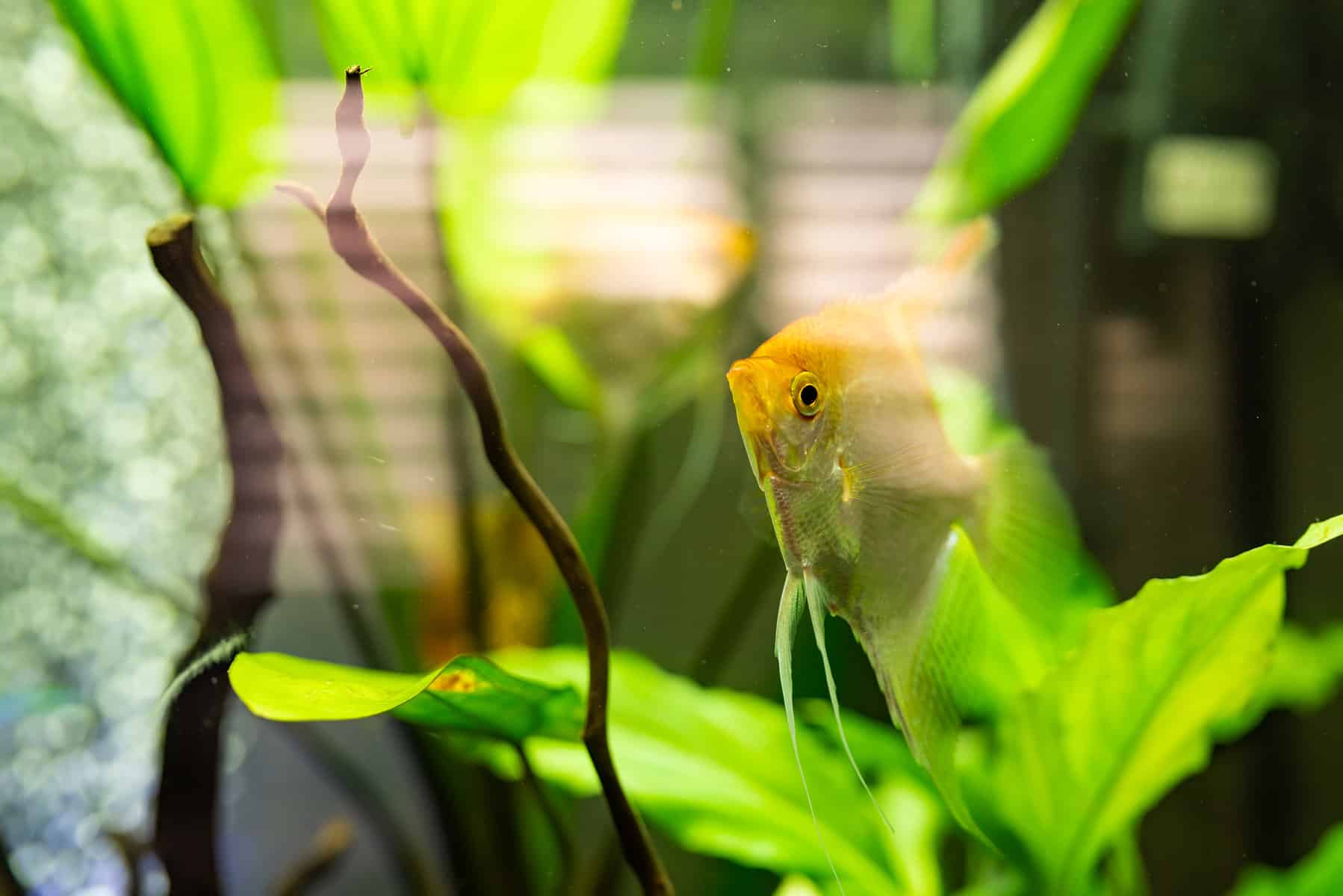The right choice of lighting can transform the most modest fish tank into something quite spectacular!
These days, you can buy lighting units that offer lots of different styles and colors of illumination, including LEDs. In fact, many tanks come with LED lighting rigs included as part of the tank hood. LEDs are the cheapest lights to run, and they’re also some of the brightest.
So do LED lights hurt fish eyes? Well, the good news is that LED lights don’t harm your fish!
Read this article on LED lights to find out more about the pros and cons of using LED lights in your fish tank!
Is LED Light Harmful to Your Fish?
No! LED lights won’t harm your fish or hurt their eyes. In fact, your fish need lights in their tank to remain healthy and thriving.
How so? After all, the degree of light in a fish’s natural environment is diffused by vegetation or the water’s depth, whereas in a fish tank, the light tends to be much brighter to enable you to see your fish.
Do Your Fish Need LED Lights?
Most fish species do not need bright lights in their tank to thrive. In fact, lots of fish species come from a natural habitat where the light is relatively dim and shaded by overhanging trees.
However, diurnal fish species need to know when it’s day and night. When the sun rises, the fish know that it’s time to feed, and when the sun sets again, the fish rest.
Conversely, nocturnal fish come out to hunt and feed under cover of darkness, staying hidden during daylight hours.
If your fish tank doesn’t have any lighting, the fish will quickly become stressed as their natural biorhythms are disrupted.
How Much Light Does Your Fish Need?
Remember that most species of fish don’t have eyelids.
The purpose of eyelids in mammals is to prevent the eyeball from drying out and to keep it clear of foreign bodies, such as dust. But fish live in water, so that problem doesn’t arise.
Of course, not having eyelids means that fish can’t physically shut out the light. You’ll notice that nocturnal fish species will hide in caves or underneath pieces of wood during the day, only emerging when your tank lights go out at night.
In addition, many fish appreciate the inclusion of dense planting or hiding places in their habitat so that they can get away from the lights when they want to.
If your fish and other livestock are exposed to too much LED light, a few problems could arise.
- Too much light can overstimulate the fish, causing them to be active for longer. That can stress the fish, compromising the creatures’ immune system and leaving your pets vulnerable to attack by bacteria and parasites.
- Too much LED light can cause your fish to stop eating.
- If the fish live in an environment of perpetual daylight, their body clock won’t know when it’s time to eat or rest, leading to confusion and stress.
Conversely, too little light can also cause problems for your fish. Light deprivation can cause your fish to lose their bright colors, and a lack of light can also make spawning much less likely.
Freshwater Plants
Underwater plants make a wonderful addition to any freshwater fish tank:
- Plants add aesthetic interest and beauty to your tank.
- Plants help to keep the water clean and healthy for your fish by absorbing nitrates for use as nutrients.
- Plants oxygenate the water through photosynthesis.
- Plants provide shelter and hiding places for shy fish and vulnerable fry.
However, aquatic plants need between 8 and 10 hours of overhead light every day to enable them to photosynthesize and grow. So, both your fish and your plants need light each day to thrive.
How Does Fish Vision Work?
Most aquarium fish can see colors in much the same way that you can.
However, it’s thought that the shades and hues the fish can see are a bit different from yours. For example, fish that live in deep water environments, such as the ocean, cannot see the color red.
Predatory fish can typically focus on one single object, whereas other species that are foragers rather than hunters cannot. However, fish vision is not as sharp as that of humans and can appear blurred and contrasted.
Although that might seem like a disadvantage, fish can actually make out objects pretty clearly through a high-contrast image.
Brightness
Fish are unable to dilate and contract their iris as quickly as you and I can. In fish, the process takes around 30 to 60 minutes.
So, you can see why turning on your aquarium light in a completely dark room can alarm your fish and could even hurt your fishy friends’ eyes.
That’s why you should always switch on the room lights before you turn on your tank LEDs.
Binocular or Monocular Vision?
Human beings have binocular vision, meaning that both eyes can focus on one single object. Most fish have monocular vision, where each eye sees a different image.
Animals with binocular vision, including fish, are usually predators with forward-facing eyes. However, prey animals usually have monocular vision, and their eyes are positioned on the side of their heads.
Can Fish See in the Dark?
Fish cannot see in the dark. So, at night, diurnal fish spend most of their time hidden away in a safe spot such as a cave or amongst some bushy plants.
So, how do fish find their way around in murky, dimly-lit water?
The Lateral Line
The lateral line is also referred to as a fish’s “sixth sense.”
Fish have a series of minute holes in their scales running along the fish’s sides. The lateral line enables the betta to sense movement, vibrations, and pressure changes in the water around it.
The fish’s brain processes that information and uses it to figure out whether the fish needs to take shelter from a potential predator or simply move away to avoid a collision.
So, although fish can’t actually see in the dark, the lateral line enables them to keep safe and avoid colliding with solid objects and the sides of the aquarium.
Benefits of LED Aquarium Lights

Although some people still like to use old-school fluorescent aquarium light systems, most aquarists have transferred to LEDs. LED lights are a much better option, bringing plenty of benefits to the hobbyist, including:
- superior energy efficiency
- compact, space-saving fixtures
- precise control over the degree of light intensity delivered
- dimmable diodes that you can program to mimic sunrise, sunset, and weather effects
- color channels that allow you to blend blue, red, white, and green diodes to enhance the colors of corals, fish, and aquarium plants
So, in general, LEDs are widely regarded as the way to go for modern hobbyists.
Do Fish Need Colored LED Lights?
Your fish don’t really care what color light you use as long as it’s not too bright or prolonged.
However, colored lights can enhance the colors, hues, textures, and other aesthetics of your fish and planting. It’s all about how your eye perceives the quality of the light it receives.
You can change the colors and intensity of light around your tank to highlight particular aspects of your hardscape and aquascape or to bring out the features of your fish.
For example, deep blue light can make your corals and fish appear fluorescent, while green light enhances the look of your plants.
Adjustable Color Spectrum
LEDs have a huge advantage over traditional metal halide types of lights in that they contain a mix of white LED light diodes, together with red, green, and blue diodes (RGB), rather than relying on just one static fluorescent light bulb.
To change the intensity of the white diodes, you simply adjust the mix through the RGB setting options.
That adjustability feature and different color channels are also crucial, bearing in mind the area the lights need to cover and the look you want to achieve in your tank.
So, how do the various LED colors work?
Full-spectrum White Diodes
Full-spectrum white diode LEDs produce a mixture of colors and give a similar effect to natural sunlight.
In nature, as sunlight enters the water, long red wavelengths are filtered out, while the shorter green and blue ones penetrate deeper. To bring out the colors of your fish and plants, you need to replicate that effect in your fish tank.
White LEDs for the fish tank are typically categorized by a K-rating and split into two types, depending on their range, as follows:
Daylight neutral 5,500K to 8,000K
Diodes in the daylight neutral range are perfect for most freshwater fish tanks, producing a neutral-colored, warm white light.
That effect is ideal for aquariums replicating shallow habitats such as lakes and streams. The long wavelength saturation of these LEDs can really accentuate the earthy, pink, orange, and red tones of plants, decorations, and fish in your tank.
The main problem with these warmer-hued white diodes is that they can encourage algal bloom, in particular in the 5,500K range.
If you keep blue or iridescent fish, you might need to alter your RGB diodes to enhance the fish’s colors.
Cool tone 10,000K and upward
If you keep a large, deep freshwater aquarium or a marine tank, warm tones can leave your setup looking rather flat and dull.
That’s because those habitats are naturally illuminated by short light wavelengths, which is why the color blue is much more effective.
Using blue or cool white lights for fish tanks is perfect for highlighting your corals in a reef tank or making blue, purple, and iridescence in your fish really pop.
However, you can alter the look across the rest of your tank by adjusting the RGB mix. As you increase the K-rating, you’ll see that the light starts to shimmer, appearing much like natural sunlight in the ocean.
For example, if you have a cichlid tank, an LED light unit rated around 10,000K will enhance your fish’s purples, blues, violets, and iridescence.
If you have a reef tank, a light that generates up to 25,000K will effectively mimic the deep blue ocean vibe.
RGB Diodes
The main advantage of using a high-quality LED lighting system is that you get RGB diodes included in the unit.
RGB diodes produce specific light spectrums and are not K-rated like the white diode systems, as explained above.
You can alter the mix and intensity of the RGB diodes to suit and enhance the appearance of your tank.
Warm spectrum diodes
If you want to bring out the earth tones, red, and orange colors of your aquarium, you can increase the intensity of the warm spectrum diodes and reduce the cool or blue channels of your LED lighting unit.
Some adjustment of the white diodes might also be required, but you’ll need to refer to the manufacturer’s directions for your specific unit for instructions.
Cool spectrum and actinic light diodes
LED lighting fixtures that blend white and blue lights are perfect for a marine or reef tank since they enhance the color of corals.
Actinic lights give off a deep blue color in the 420nm spectrum, creating a moonlight effect in your tank. Most modern LED units include actinic moonlight diodes and have color channels that allow you to alter the levels of green, blue, and purple.
Those cool spectrum LED lights can be used to create shimmering effects or add a subtle glow to your tank.
You can add a separate blue LED moonlight LED if you want to, which will enable you to blend its colors with your main LED light fixture.
Can I Use Sunlight Rather Than LED Light in My Aquarium?

Since fish don’t actually need bright aquarium LED lights, you might wonder whether you could simply put your fish tank where it will receive lots of direct sunlight.
After all, that would save you money on purchasing lights and would replicate the fish’s natural environment pretty closely, right?
No! We do not recommend putting your fish tank in direct sunlight.
Algae
If your tank receives lots of direct natural light, algae will certainly bloom and grow.
Algae are not harmful to your fish, and some fish species happily graze on the green growth as a valuable addition to their diet.
However, excessive algae will rapidly spread and coat your viewing panes, decorations, and filter unit with an unattractive green slime.
Algae also grow on your plants, eventually coating the leaves, suffocating the plants, and outcompeting them for nutrients. That said, algae absorb nitrates from the water in the same way that plants do, helping to keep the water healthy for your fish.
So, although a small number of algae in the aquarium can be beneficial, you don’t want too much algal growth.
Temperature Fluctuations
Most fish species don’t appreciate fluctuations in water temperature and can suffer from temperature shock if the water is too hot.
If your fish tank catches the sun throughout the day, the water temperature can rapidly rise, stressing the fish and even resulting in mass fish kills.
Reflections
One thing you must be aware of is that lots of light in your fish tank can cause reflections, which can cause problems for some fish species.
Territorial fish, such as bettas and some cichlids, can become stressed by reflections in the aquarium viewing panes, and that can trigger aggression toward their tank mates.
The following tips can help to prevent LED lights from creating reflections in your tank:
Exterior Lighting
Only switch on your aquarium lights when the main room light is on. Most reflections happen when the tank is lit from within, and the exterior lights are off.
Introduce Light Gradually
When you buy new fish, you can help to acclimate them to their new tank by introducing your lights gradually.
So, turn the light on for a couple of hours each day, increasing the time until your fish remain calm and are not disturbed by the lights.
Use Aquarium Paper
Placing aquarium paper on the outside of the fish tank glass is effective at preventing reflections on the inside.
If you prefer, you can paint the exterior of the glass with aquarium-safe paint in a color of your choice.
Use Aquatic Plants
Placing a few thick, bushy plants in front of the areas of your glass that tend to catch reflections can be a very effective way of keeping reflections to a minimum.
Extra plants are also an excellent way of improving the water quality in your aquarium and providing shelter for your fish.
Final Thoughts
Did you enjoy our guide to using LED light for freshwater aquariums? If you did, please take a moment to share the article.
LED lights don’t hurt fish eyes, provided that you provide the fish with some form of shelter and shade so that they are not constantly exposed to light.
Fish actually need some lighting in their tank to tell them when it’s day and night. If you keep underwater plants in your tank, you’ll need to provide 8 to 10 hours of light every day so that the plants can photosynthesize.
What lighting unit do you use for your fish tank? Are you still devoted to fluorescent tubes, or have you converted to LEDs? Tell us in the comments box below.


























